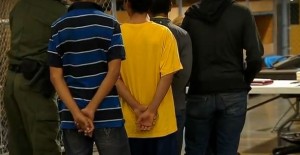Questions surround planned immigration detention center in NM

YOUNG DETAINEES: As many as 700 children and parents are about to be processed at a detention center in Artesia, N.M.
By Rob Nikolewski │ New Mexico Watchdog
SANTA FE, N.M. — Trying to stem a tide of thousands of undocumented immigrants, as many of 50,000 of them children, the U.S. Department of Homeland Security is about to convert a training center for the U.S. Border Patrol in the southern New Mexico town of Artesia into a detention center.
But Gov. Susana Martinez said Tuesday morning she’s concerned about a host of questions, ranging from how the children and their families will be cared for to making sure state and local agencies aren’t stuck picking up part of the bill.
“It is a federal facility and it’s their facility so they should incur all costs,” Martinez told New Mexico Watchdog. “But at the same time, we’re not going to leave a child hungry or without medication because of the failed (immigration) policy in Washington. We’re just not going to do that.”
Elected officials across the state are still getting answers about the Federal Law Enforcement Training Center in Artesia, which is being converted to house as many as 700 immigrants, nearly all of them from Central America.
Officials from the Department of Homeland Security, Immigration and Customs Enforcement and FLETC met with state and local officials at the training center Monday and Tuesday.
Dennis Kintigh, the mayor of Roswell, located 41 miles from Artesia and just eight miles from the county line, was among those at Tuesday’s meeting and told New Mexico Watchdog what was shared by federal officials:
TRANSITION: The Federal Law Enforcement Training Center in Artesia is expected to start taking in immigrant families who entered the U.S. illegally as early as Thursday or Friday.
*The facility will not be taking unaccompanied minors
*Families may be entering the facility as early as Thursday or Friday, with officials expecting as many as 50 individuals being housed at first
*Federal officials expect the facility, made up of 20 family units, to be open for 6-12 months. “I think it’s going to go longer than that, though,” Kintigh said.
*Immigrants will be coming in and out on a rotating basis, with new arrivals replacing those who are processed out of the facility. The average processing time will be 30 days.
*The immigrants will be housed in modular dormitories that are already on site
*Kintigh said federal officials told state and local representatives the facility will house “only the lowest-level risk” immigrants. “They’re not going to be gang-bangers, they said,” Kintigh said, “although they will be sending up to 17-year-old males with a mother.”
*Chain-link fences are being constructed around the dormitories, but there will be no wires atop the fences
*Training around the facility will continue for those enrolled in the Border Patrol academy
“My concerns were more from a law enforcement perspective than about (immigration) policy,” Kintigh said. “Before this meeting, there was no coordination with law enforcement in our area or with Chaves County.”
“My main concern is, we have children who are a very young age being held in immigration camps where children don’t belong,” Martinez said, adding, “That facility is meant to keep people out, not to keep them in.”
New Mexico Watchdog emailed a list of questions to the public affairs office at DHS Tuesday afternoon. We received a fact sheet (click here to view), but the response didn’t answer questions about financial concerns or specific safety questions about the converted facility.
Rep. Bill Gray, R-Artesia, said he was impressed by the federal officials at Tuesday’s meeting. “I felt they were very honest with us,” Gray said. “I don’t know if I’m feeling better about it because there’s not much we can do about it.”
But Rep. Candy Spence Ezell, R-Roswell, said, “I have plenty of concerns.”
Ezell said an ICE official at Tuesday’s meeting estimated that 90 percent of those sent to the facility will eventually be sent back to their country of origin.
“But that means 10 percent will be given asylum,” Ezell said. “Unless we see a change in our immigration policy, I can see this going on forever … We can’t take care of our veterans, we can’t take care of our elders, we can’t take care of people who can’t help themselves and I am very bothered by this.”
Contact Rob Nikolewski at rnikolewski@watchdog.org and follow him on Twitter @robnikolewski







